STEAMBOAT (Day 4 - part 2)
For thousands of years, the Mississippi River was a trade route used by Native Americans in canoes, rafts and dugouts. The Europeans required increased volumes of transportation of both cargo and people.

Keelboats (in the late 1700s and early 1800s) were large vessels that floated or sailed downstream but had be be laboriously poled or dragged back upstream. A round trip journey to and from New Orleans could take as long as 9 months. Once the steamboat was invented, they completely disappeared.
The first steamboat on the Mississippi was in 1811. By 1849, there were at least 600 riverboats in service, despite the dangers of explosion and shipwrecks (from hitting obstacles such as rocks or logs) that sank 520 boats in less than 30 years. Between 1811 - 1853, an estimated 7,000 fatalities occurred as a result of boiler explosions on Mississippi River steamboats due to poor boiler construction and unsafe operation. Engines were often pushed well beyond their limits by engineers who frequently lacked a full understanding of them. Even so, passengers were willing to accept the risk since it was so much better than land transportation. The expansion of railroads at the end of the Civil War drastically reduced steamboat trade.

Steamboats served briefly as pushboats for barges but were soon replaced by boats with more powerful and efficient diesel engines.

The Str. Sprague (1902 - 1948) was the largest steam-powered sternwheel towboat ever built. Its paddlewheel was 40 feet in diameter.
The boiler room...
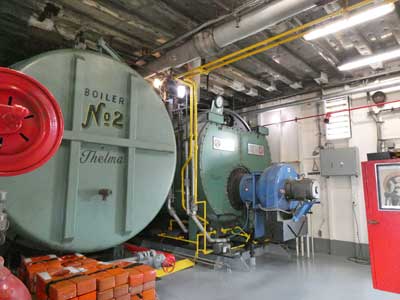

The two boilers are named Thelma and Louise. Originally they burned coal, but diesel fuel is now used, which is cleaner. The boilers heat the water, creating 200 pounds per square inch of steam pressure which is sent to the engine room to power the steam engines.


The boilers burn some 100 - 125 gallons of fuel per hour.
The engine room...
The first Natchez was built in 1823 in New York City. It was a low pressure, sidewheel steamboat that carried passengers and cargo between New Orleans and Natchez, Mississippi. The name "New Orleans" was already taken by the first steamboat to travel the Mississippi in 1811. It was destroyed by fire in 1835.
The second Natchez was built in 1846. It was a fast two-boiler boat. It was sold in 1848 and abandoned 4 years later.
The third Natchez was funded by the sale of the second one. It sank in 1866 due to rotting.
The fourth Natchez was 270 feet long, had six boilers and could hold 4,000 bales of cotton. It was only operational six weeks when it collided with (and sank) another ship in January 1854. It burned in a New Orleans wharf fire just over a month later along with a dozen other ships.
The fifth Natchez was promptly built and used until 1859. In 1860, it was destroyed while serving as a wharfboat at Baton Rouge, Louisiana.

The sixth Natchez was 273 feet long, with a capacity of 5,000 cotton bales. During the Civil War, it was used to transport Confederate troops to Memphis, Tennessee. After Union soldiers captured that city, the boat was moved to the Yazoo River. In 1863, it was burned either by accident or to keep her out of Union hands.

The seventh Natchez, built in 1869, was 301 feet long, had eight boilers and a capacity of 5,500 cotton bales. With 401 trips over almost 10 years of service, it never had a single deadly accident. The boat was dismantled in 1879.

The eighth Natchez was launched in 1879. It had eight steel boiler, thirteen engines, and 47 elegant staterooms. By 1887, problems began to incur due to a lack of business. In 1888, it was renovated back to perfect condition but unfortunately burned in 1889.
The ninth and current Natchz is a sternwheel riverboat. Built in 1975, it is not modeled after the original Natchez, but rather the steamboats Hudson and Virginia. Many of its parts were taken from the Clairton, including the steam engines and steering system. It is 265 feet long and weighs 1,384 tons. Because it is flat-bottomed, it only requires water 6 feet on which to float.

The Clairton


The two steam engines drive the pistons, which turn the rear paddle wheel. Each 7-foot-long engine was custom made in 1925. They were first installed on the towboat Clairton to push coal barges from 1927-1965. They are rated 1600 horsepower. High pressure steam is pushed alternately to one side of the piston and then the other side. After the steam has expanded, it is sent to a condenser and cooled by river water. the water is filtered and returned to the boiler to be reheated into steam at a rate of 20 gallons per minute.

Diagram of how the steam engine works

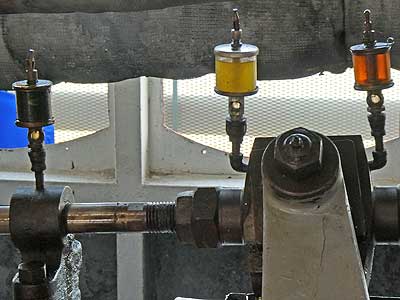

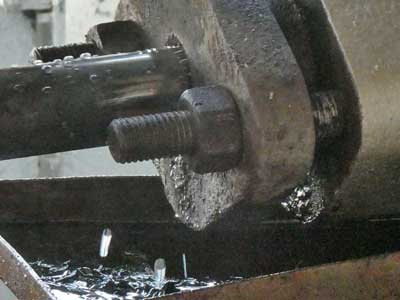
Steam and water droplets spurted forth from many of the moving parts.





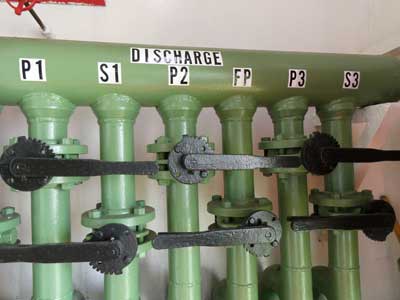

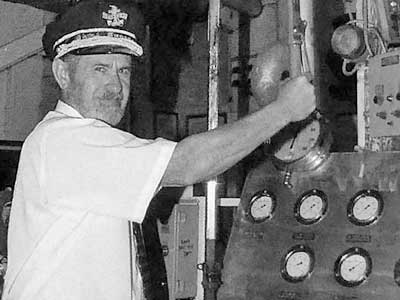
To communicate with the chief engineer far below in the engine room, the pilot uses a telegraph. The pilot turns a knob to the position he wants. This turns the corresponding dial in the engine room and sounds a bell. The engineer then turns his knob to the corresponding position which stops the bell, indicating he has received the signal.


The ship has no propellors, just a paddlewheel and three 17-foot-long rudders. The steering system was taken in its entirety from the Clairton.
It was departure time!


Raising the ramp


Overseeing operations


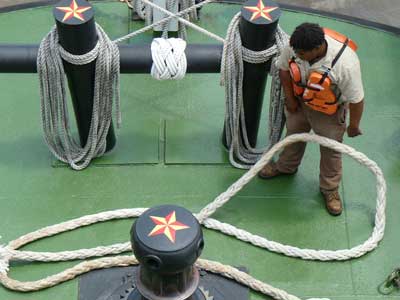
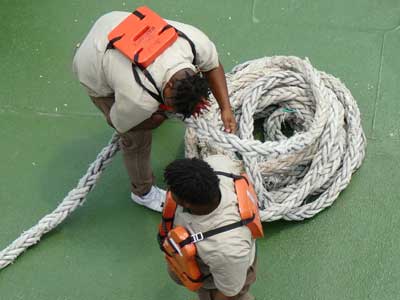

The steamwhistle signals our departure.
On average, the river is 100 feet deep. At the dock it's 40 feet, and its deepest section is at the nearby bend in the river, at 200 feet deep. Apparently the river was currently high from melting snow.


Rocks line the river banks. This helps protect from the wash coming from the large, passing ships.
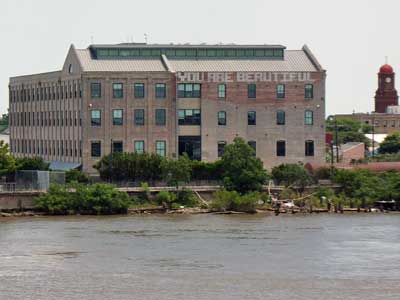

Rice Mill Lofts is a five-story residential building which opened in 2013. The structure, originally built in 1892, was once home to the largest rice mill in North America. Hurricane Betsy removed part of the roof in 1965. During renovations starting in 2010, the building was heavily vandalized. However it was decided to keep much of the original graffiti, including a large "You are Beautiful" mural.


The steel Piety Street Bridge, known as the Rusty Rainbow, allows pedestrians to cross over some railroad tracks and enter Crescent Park. The park is named for the large "crescent" bend in the river on which it is located. The dock damage is from Hurricane Katrina.
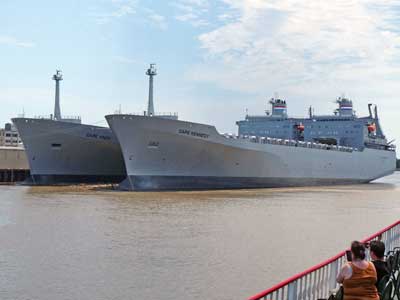

The two Ready Reserve Force (RRF) ships, the Cape Kennedy and Cape Knox, were brought here in 1996. The military supply ships serve as a link between US factories and the frontline of either peacekeeping or humanitarian missions. They can be mobilized within a matter of days.
Each of the vessel is 700 feet long and 106 feet wide, and has three cargo decks with connecting ramps. With an operating range of more than 21,000 nautical miles, it can cross the Atlantic in 6 days.


These numbers are called draft marks and indicate the distance to the bottom of the ship's keel. They basically measure the ship's depth. They help ensure the ship is not overloaded, to reduce the risk of capsizing or flooding. The draft of a ship can change depending on the load, water temperature and water salinity. ... The letters indicate different conditions such as winter temperature water, summer temperature, tropical seawater, fresh water and so on. The circular disc with a line through it is the Plimsoll Line Disc or load line disc. This marks the summer saltwater line.


Known as roll-on/roll-off vessels, they have stern (rear) and side ramps enabling wheeled cargo (including large containers and even tanks) to be driven on and off. The ships can therefore be loaded and unloaded much faster than conventional ships.
return • continue

